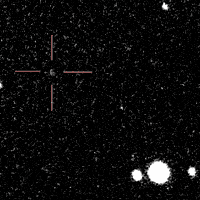7167 Laupheim
 | |
| Discovery[1] | |
|---|---|
| Discovered by | Carolyn S. Shoemaker, Eugene Shoemaker |
| Discovery site | Palomar Observatory |
| Discovery date | 12 October 1985 |
| Designations | |
| 7167 Laupheim | |
Named after | Laupheim |
| 1985 TD3; 1991 VR4 | |
| Main Belt | |
| Orbital characteristics[2] | |
| Epoch 13 January 2016 (JD 2457400.5) | |
| Uncertainty parameter 0 | |
| Observation arc | 11141 days (30.50 yr) |
| Aphelion | 3.7768 AU (565.00 Gm) |
| Perihelion | 2.4827 AU (371.41 Gm) |
| 3.1297 AU (468.20 Gm) | |
| Eccentricity | 0.20673 |
| 5.54 yr (2022.4 d) | |
Average orbital speed | 16.82 km/s |
| 137.54° | |
| 0° 10m 40.836s / day | |
| Inclination | 23.470° |
| 219.58° | |
| 181.58° | |
| Earth MOID | 1.48978 AU (222.868 Gm) |
| Jupiter MOID | 1.64813 AU (246.557 Gm) |
| TJupiter | 3.055 |
| Physical characteristics | |
| 7.0405 h (0.29335 d) | |
| 12.0 | |
7167 Laupheim[2] is a main-belt asteroid which was discovered in 1985 at the Palomar Observatory by Carolyn S. Shoemaker and Eugene Shoemaker.
After visiting the public observatory in Laupheim, southern Germany, in 1998, Carolyn Shoemaker was so impressed with the work done at this institution that 1985 TD3 was named Laupheim on 4 May 1999, in honor of Robert Clausen and his team.[3] Clausen founded an association of amateur astronomers in 1975 which organized traveling astronomical exhibitions and numerous international astrofests. Since 1990 Clausen and his coworkers have also been running a Zeiss planetarium and observatory.[4]
References
- ^ Discovery Circumstances: Numbered Minor Planets 5001-10000
- ^ a b JPL
- ^ http://www.planetarium-laupheim.de/ueber-uns/volkssternwarte-laupheim-ev/7167-laupheim/ Press release from the public observatory in Laupheim with a photograph of the asteroid (in German)
- ^ http://www.minorplanetcenter.net/db_search/show_object?object_id=laupheim Minor Planet Center
